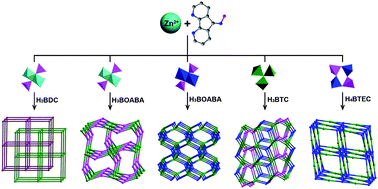An investigation into the molecular tectonics of metal–organic frameworks (MOFs) is reported on the basis of N-donor ligand modulated polynuclear zinc clusters and different aromatic polycarboxylic ligands. A series of three-dimensional (3D) coordination frameworks, [Zn2(BDC)1.5(L)(OH)]·H2O (1), [Zn2(BOABA)(L)(OH)]·2H2O (2), [Zn2(BOABA)(L)(OH)]·4H2O (3), [Zn3(BTC)2(OH)]·0.25H2O·[N(C4H9)4] (4) and [Zn2(BTEC)0.5(L)(OH)2] (5), were synthesized by self-assembly of zinc ions with a new N-donor ligand 4,5-diazafluoren-9-oxime (L) and the aromatic polycarboxylic ligands 1,4-benzenedicarboxylic acid (H2BDC), 3,5-bis-oxyacetate-benzoic acid (H3BOABA), 1,3,5-benzenetricarboxylic acid (H3BTC), and 1,2,4,5-benzenetetracarboxylic acid (H4BTEC). Compound 1 exhibits a twofold interpenetrated α-polonium-type network based on tetranuclear Zn clusters as six-connected vertices and BDC ligands as linkers. Compound 2 also consists of tetranuclear units, it shows a (3,6)-connected rutile network, where tetranuclear zinc clusters act as six-connected nodes and BOABA ligands act as three-connected nodes. Compound 3 is an isomer of compound 2, due to the different configuration of tetranuclear zinc, it displays a novel (3,6)-connected network with a complex (4·62)2(42·69·84) topology. In 4, the connection between the trinuclear zinc clusters and the BTC ligands results in an infinite 3D (3,6)-connected network with point symbol (4·62)(63)(4·611·83). Compound 5 constitutes a lvt net, which is built from tetranuclear clusters and BTEC as four-connected nodes, respectively. The results indicate that various polynuclear zinc clusters are modulated by L ligands combining with Zn atoms via chelation or monodentate coordination, or acting as a structure-directing agent. Meanwhile, aromatic multicarboxylic acids also play important roles in the construction of the compounds with various structures.


 Please wait while we load your content...
Please wait while we load your content...